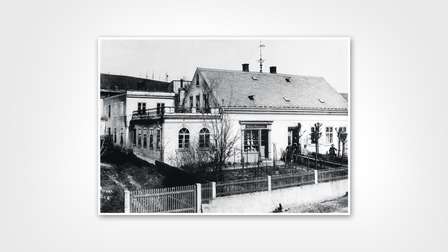
Origins
The estate looks today like it did 142 years ago.
Ferdinand
“This place is truly unique,” enthuses Andrea Frydlová. “It offers a glimpse into not only the life and significance of Ferdinand
Today, the estate looks almost exactly like it did back then: a proper picket fence, a cobblestone courtyard, a well-tended yard, and the home and workshop at the heart of the grounds. “The reconstruction and renovation of the estate was complex and time-consuming—and a great success,” says Frydlová. The art historian is both the director of the Škoda Museum in Mladá Boleslav (around fifty kilometers away) and the lady of the house, so to speak, at the birthplace of Ferdinand
![[+]](https://files.porsche.com/filestore/image/multimedia/none/christophorus-issue381-article05-content-01/normal/26749255-194c-11e7-9f74-0019999cd470/porsche-normal.jpg)
Line of development: Semper Vivus, the first hybrid car in the world, designed by Ferdinand
“The exhibition at the house where Ferdinand
Upon entering the museum, visitors receive an iPad on which they can delve into details according to their interests. Each exhibit is given a small symbol that can be scanned with the tablet to unlock a plethora of additional information, photos, and videos, allowing the user to decide how deeply they would like to examine the particular theme. With a few swipes of the finger, the visitor is suddenly right in the midst of the Sturm und Drang phase of the young Ferdinand
The fourteen-year-old, however, was much more interested in electricity than pipes and threads. As often as he could, he would visit the Ginzkey spinning mill a few streets away. At the time, Ginzkey was the largest company in Maffersdorf and known well beyond the borders of Bohemia. The plant housed some 250 perpetually chattering mechanical looms that produced mainly blankets and rugs. Years later, in the 1920s, what was then the largest rug in the world was made there for the Waldorf Astoria hotel in New York.
![[+]](https://files.porsche.com/filestore/image/multimedia/none/christophorus-issue381-article05-content-02/normal/8f6cc0ce-194c-11e7-9f74-0019999cd470/porsche-normal.jpg)
Lady of the house: Andrea Frydlová directs the Škoda Museum in Mladá Boleslav and is also responsible for the recently opened birthplace of Ferdinand
History: Visitors to the museum can undertake a journey of discovery into the fascinating history of
The state-of-the-art electrical system in the factory so fascinated Ferdinand
His mother Anna
That same year, Ferdinand
Forming the centerpiece of the exhibition is a replica of the first hybrid car designed by
The car was a milestone in automotive history—and yet only the beginning of Ferdinand
![[+]](https://files.porsche.com/filestore/image/multimedia/none/christophorus-issue381-article05-content-03/normal/cd875a85-194c-11e7-9f74-0019999cd470/porsche-normal.jpg)
Birthplace of Ferdinand Porsche
Tanvaldská 38
Vratislavice (Maffersdorf),
Czech Republic
Opening hours:
Friday to Sunday
9:00 a.m. to 5:00 p.m.
www.porsche-house.com
Vienna
In 1893, at the age of eighteen, Ferdinand
Porsche Villa, Stuttgart
In 1923 Ferdinand
Steyr
After Ferdinand
Kronenstrasse 24, Stuttgart
On April 25, 1931, Ferdinand
Schüttgut
Located in an Alpine pasture above the town of Zell am See, this six-hundred-year-old estate catches the eye of Ferry
Gmünd
After the Allied bombing raids of Stuttgart in late 1944, Ferdinand
By Sven Freese
Photos by Thorsten Doerk,
![[+]](https://files.porsche.com/filestore/image/multimedia/none/christophorus-issue381-article05-margin-01/normal/fc31b734-194b-11e7-9f74-0019999cd470/porsche-normal.jpg)
![[+]](https://files.porsche.com/filestore/image/multimedia/none/christophorus-issue381-article05-margin-02/normal/49882f9d-194d-11e7-9f74-0019999cd470/porsche-normal.jpg)
![[+]](https://files.porsche.com/filestore/image/multimedia/none/christophorus-issue381-article05-margin-03/normal/e0da43d9-194f-11e7-9f74-0019999cd470/porsche-normal.jpg)
![[+]](https://files.porsche.com/filestore/image/multimedia/none/christophorus-issue381-article05-margin-04/normal/f9667c29-194f-11e7-9f74-0019999cd470/porsche-normal.jpg)
![[+]](https://files.porsche.com/filestore/image/multimedia/none/christophorus-issue381-article05-margin-05/normal/15956fa0-1950-11e7-9f74-0019999cd470/porsche-normal.jpg)
![[+]](https://files.porsche.com/filestore/image/multimedia/none/christophorus-issue381-article05-margin-06/normal/3bb76948-1953-11e7-9f74-0019999cd470/porsche-normal.jpg)
![[+]](https://files.porsche.com/filestore/image/multimedia/none/christophorus-issue381-article05-margin-07/normal/3bb76949-1953-11e7-9f74-0019999cd470/porsche-normal.jpg)
![[+]](https://files.porsche.com/filestore/image/multimedia/none/christophorus-issue381-article05-margin-08/normal/955cb751-1953-11e7-9f74-0019999cd470/porsche-normal.jpg)








